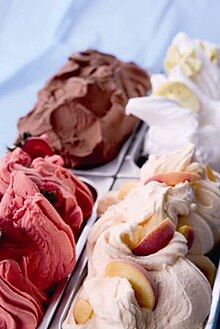Gelato
This article needs additional citations for verification. (November 2009) |
 | |
| Type | Gelato |
|---|---|
| Place of origin | Italy |
| Region or state | Sicily |
| Serving temperature | Cold |
| Main ingredients | 3.25% milk, sugar, flavoring (fruit, nut, chocolate, ...) |
Gelato (Italian pronunciation: [dʒeˈlaːto], lit. 'ice cream') is a frozen dessert of Italian origin. Artisanal gelato in Italy generally contains 6-10% butterfat, which is lower than other styles of frozen dessert.[1][2] Gelato typically contains 70% less air and more flavoring than other kinds of frozen desserts, giving it a density and richness that distinguishes it from other ice creams.[3][4]
History[]
The Arabs developed shrb (sugar syrup) and in Palermo they grew 400 different types of flowers to flavor their sorbets.[5] Gelato in its modern form however, is credited to the Italian chef Francesco Procopio dei Coltelli who in the late 1600s opened his "Café Procope" in Paris and introduced gelato at his café, earning notability first in Paris and then in the rest of Europe. Thanks to his gelato, Procopio not only obtained French citizenship, but also got an exclusive royal licence issued by King Louis XIV, making him at the time the sole producer of the frozen dessert in the kingdom.[6]
In the 1900s-1950s, different innovations made the automatic production of gelato easier. The Motogelatiera was created, which was the first automatic machine that made gelato.[5] Other innovations like the batch freezer made it easier to store frozen desserts such as gelato.[5] Around the 1940s, Bruto Carpigiani worked to create machines that would make the production of gelato safer and easier.[7] Nowadays, Carpigiani is one of the biggest manufacturers of gelato machinery.[7] Today, gelato is known worldwide and Italy is the only country where the market share of artisanal gelato versus mass-produced gelato is over 55%.[8][9]
Flavors[]
Traditional flavors of gelato consist of vanilla, chocolate, hazelnut, almond, pistachio, cream (also known as custard) and stracciatella (fior di latte gelato with chocolate chunks).[10] Fior di latte ("milk flower") is plain, base ice cream with no flavor and no eggs added.
More modern flavors consist also of fruity flavors such as raspberry, strawberry, apple, lemon and pineapple.[10]
Production[]
The process consists of heating the ingredients to 85 °C (185 °F) for pasteurization. Then, it is lowered to 5 °C (41 °F) and mixed to the desired texture.
The cold process mixes the ingredients and is batched in the freezer.
In the "sprint" process, milk or water is added to a package of ingredients which is then mixed and batched.[11]
As with other ice creams, the sugar in gelato prevents it from freezing solid by binding to the water and interfering with the normal formation of ice crystals. This creates smaller ice crystals and results in the smooth texture of gelato.[12] American commercial gelati are typically sweetened with sucrose, dextrose, or inverted sugar, and include a stabilizer such as guar gum.
See also[]
- Custard, a dessert made with cream, eggs and vanilla
- Frozen custard, a frozen dessert made with cream and eggs
- Frozen yogurt, a frozen dessert made with a base of yogurt rather than milk
- Granita, a semi-frozen dessert made from sugar, water and various flavorings
- Italian ice, also known as water ice, a frozen dessert made from either concentrated syrup flavoring or fruit purees
- Semifreddo, a class of semi-frozen dessert
- Sorbet, called sorbetto in Italian
- Stracciatella
Notes[]
- ^ "Calorie e valori nutrizionali del gelato", Paginemediche [1]
- ^ M.T. Wroblewski (6 December 2018). "Nutrition Facts on Gelato Compared to Ice Cream". San Francisco Gate. Retrieved 20 August 2014.
- ^ Ferrari, p. 21
- ^ Sylvia Poggioli (17 June 2013). "Italian University Spreads The 'Gelato Gospel'". NPR. Retrieved 7 July 2016.
- ^ a b c "History". Carpigiani Gelato Museum. Retrieved 3 May 2021.
{{cite web}}: CS1 maint: url-status (link) - ^ Olga Stornello (1 November 2018). "Francesco Procopio dei Coltelli: the man who invented gelato". Sicilian Post. Retrieved 8 August 2019.
- ^ a b "Taste the History of Gelato". ITALY Magazine. Retrieved 3 May 2021.
- ^ "ItalianGelato.info".
- ^ "GelatoArtigianale.it".
- ^ a b "WhyGelato? | Because the Tradition of Simple Indulgence Never Gets Old". WhyGelato.com. Retrieved 16 April 2018.
- ^ "WhyGelato? | Because There's More Than One Way to Create a Masterpiece". WhyGelato.com. Retrieved 24 April 2018.
- ^ Omran, A. Monem (July 1974). "Kinetics of ice crystallization in sugar solutions and fruit juices". AIChE Journal. 20 (4): 795–803. doi:10.1002/aic.690200422.
References[]
- Ferrari, Luciano (2005). Gelato and Gourmet Frozen Desserts – A professional learning guide. Lulu.com. ISBN 978-1-4092-8850-3.[self-published source]
External links[]
| Wikimedia Commons has media related to Gelato. |
- Frozen desserts
- Ice cream
- Italian desserts
- Italian inventions
- Italian words and phrases
- Cuisine of Sicily